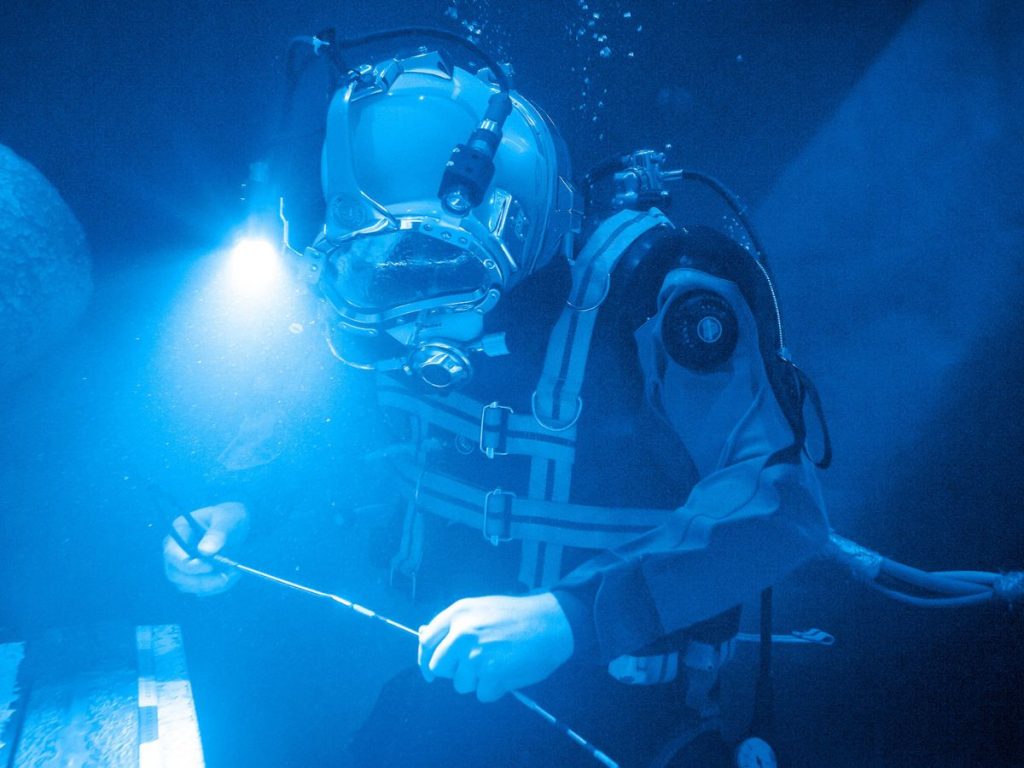What exactly is underwater welding and how does it work?
The notion of underwater welding is extremely fascinating. And if you’re seeking for more information about the procedure, you’ve come to the correct place.
Are you familiar with hyperbaric welding? When we undertake a hyperbaric welding procedure in a wet environment or surrounding, it is referred known as underwater welding. Many people get the terms underwater welding and hyperbaric welding mixed up. If and only if a hyperbaric welding procedure is performed in an environment with water, it is referred to as underwater welding.
Humans have been doing underwater welding since 1930. It is commonly utilized for maintaining the underwater marine infrastructure.
It is divided into two types:
Wet Welding
Welders clearly prefer Shielded Metal Arc Welding (SMAW) since it is the most effective and cost-efficient welding technology. Stick Welding is another name for Shielded Metal Arc Welding. An electric arc is created between the electrode and the base metal via Stick Welding. The base metal is usually copper or aluminum in most circumstances.
Drivers must be highly alert and obey many guidelines throughout the wet underwater welding process (WUW). The most critical thing for the welder to perform here is to maintain the electrode clean.
When the welders are ready, they usually notify their respective teams to pass the current when the electrode comes into contact with the base metal.
What kind of current is used in wet welding? Direct current is used in the wet welding process. In underwater settings, direct current is much safer than alternating current.
The following is how the wet underwater welding technique works:
- The work to be welded is connected to one end of the electric circuit, while a metal electrode is connected to the other.
- The given current causes the electric arc to develop. The naked metal is then welded, and a weld pool is formed.
- The electrode melts as a result of the heat generated, and metal droplets are projected into the projected region. Simultaneously, the flux coated on the electrode melts, forming the shielding gas. This shielding gas is used to keep the arc column stable.
Wet underwater welding process requirements:
- Current requirements: 300 to 400 amps. DC generators or motor generators
- Manifolds for gas
- Converting power
- Welding machine
- Converting power
Wet underwater welding employs two welding processes:
1. FCAW (Flux-Cored Arc Welding):
An electrode is used in flux core arc welding to join alloys comprised of nickel and cast iron.
2.FW (Friction Welding):
Friction and heat are employed in friction welding to melt the metal.
WUW Advantages
Low price:
The most significant advantage of wet underwater welding is that it is far less expensive than dry underwater welding.
It is also versatile in terms of execution.
Quick and simple:
The WUW procedure is simpler to carry out. We can do things much faster and more effectively.
Can Weld in Difficult Places:
The primary benefit of wet underwater welding is that it enables users to weld in the difficult offshore environment. Another welding procedure is difficult to do in the intricate offshore constructions.
The following equipment is required:
Wet underwater welding requires very little equipment. This process necessitates the use of a standard welding machine as well as a few other machines.
Wet Underwater Welding has the following disadvantages:
Lower Strength:
The strength of the weld created during wet underwater welding is very low. This is due to the quick quenching process. Rapid quenching also has an impact on ductility. In short, this welding affects both strength and ductility.
Inadequate efficiency:
Because the whole process takes place in water. We must deal with the problem of inadequate visibility. We can’t execute the welding effectively because of the limited vision.
Wet Welding:
A unique sort of chamber is employed as a welding environment in the dry welding process. Welding is performed in the same manner as in a standard welding operation. However, a seal-like structure is formed around the region to be welded. In such a region, there is a combination of gases such as helium and oxygen.
The following four dry welding processes are employed in underwater dry welding:
Welders utilize a room-sized chamber with the same pressure outdoors to perform habitat welding.
Dry Spot Welding: Dry spot welding is often used for smaller-sized chambers. The chamber here is as tiny as the size of a person’s head. The electrode must be inserted into the chamber by the welder.
Pressure Welding: A pressure of one atmosphere is normally present in pressure welding.
Dry Chamber Welding: The size of the chamber in dry chamber welding is generally larger than the size of the chamber in dry spot welding.
Dry underwater welding also use shielded metal arc welding (SMAW). Along with shielded metal arc welding, the following welding processes may be utilized on occasion:
1. Arc Plasma Welding
An electric arc is employed in plasma arc welding. The intense heat produced by the generated electric arc is used for welding aluminum, stainless steel, and other materials.
2. Tungsten Arc Welding using Gas:
GTAW stands for gas tungsten arc welding. TIG welding is another term for it. A non-consumable electrode is employed in the GTAW. This electrode is often constructed of tungsten. Heat is produced after the development of the electric arc. Aluminium alloys and stainless steel may be readily welded using the GTAW method.
Welding using a Gas Metal Arc:
GMAW is an abbreviation for Gas Metal Arc Welding, which is also known as MIG welding. A shielding gas is utilized in Gas Metal Arc Welding. The welding gun is surrounded by a shielding gas. Shielding has aided in the welding of nonferrous metals such as aluminum.

